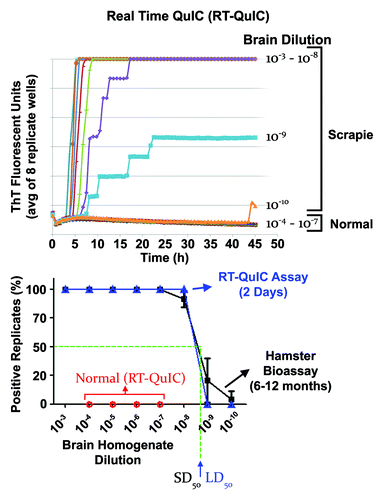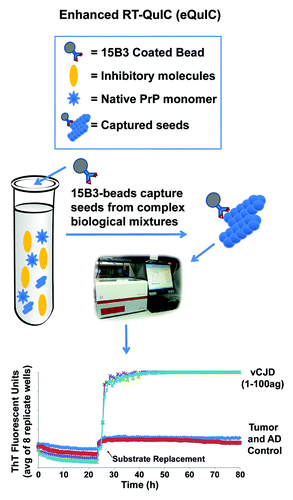Figures & data
Table 1. Comparison of selected highly sensitive prion/PrPSc assays
Figure 1. End-point dilution quantitation of prion seeding activity by RT-QuIC. Top panel: We show the average relative fluorescence from RT-QuIC reactions seeded by dilutions (8 replicate wells per dilution) of hamster 263K scrapie brain homogenates as a function of time. With more dilute seed samples, the lag phase prior to the rapid fibrilization phase increases and stepwises increases in the fluorescence can be seen as individual reactions become positive. Near the endpoint dilution (in this case the 10−9 dilution) only a subset of the replicate reactions became ThT positive. Bottom panel: Comparison of proportion of positive replicate RT-QuIC reactions (blue) and clinically affected hamsters (black) inoculated with the designated dilutions of 263K scrapie hamster brain homogenate. Normal brain controls are shown in red for the RT-QuIC. From these curves, estimates of the SD50 and LD50 can be made, however, we typically make these estimates using Spearman-Karber analyses of the data.Citation44 In this example (but not all sample types), the dilutions containing an SD50 and an LD50 were similar, indicating similar sensitivities of the RT-QuIC and bioassays for these samples. However, whereas the RT-QuIC assay takes ~2 d, the bioassay take 6–12 mo for determining end-point dilutions. Adapted with permission from Wilham et al.Citation6

Figure 2. eQuIC diagram and data. In eQuIC, prion seeds are immunoprecipitated with 15B3-coated beads and the beads are added to the reaction wells to initiate the reaction. After 24 h, the substrate is replaced and prion-seeded reactions usually turn ThT-positive within several hours (if not earlier).
